
I discovered
okara during my first year in Tokyo, thanks to my neighborhood tofu shop who sold me 400 grams (0.88 lbs) of
okara every week for ¥150 (about $1.70).
Okara is translated as "tofu lees" or "soy pulp" and is a byproduct of the tofu-making process.
Maybe it's just me, but "soy pulp" sounds kind of gross, so it's one of my missions to spread more awareness to the population at large about this miracle food by referring to it as its Japanese namesake
okara. Its literal meaning in Japanese means "shell" referring to the shell casing of the soy bean which is hulled in the tofu-making process.
Websites devoted to the wonders of
okara are abundant on the "net" - for example,
here,
here and
here.
The last link takes us to a site giving us a play-by-play of some guy on the
okara diet. Perhaps not as gimmicky as the South Beach diet, but the
okara diet did cause a bit of a stir nationwide in Japan.
Okara belongs in the upper echelon of healthy and socially responsible foods - healthy because of its high protein, high fiber and low fat content, and socially responsible because it is usually thrown away in the tofu-making process.
But folks, this is the clincher: It's free at my local Japanese grocer,
Tokyo Fish Market, in Berkeley, California.
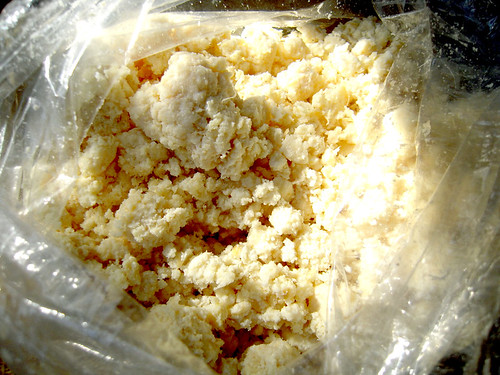
Here's a better look:
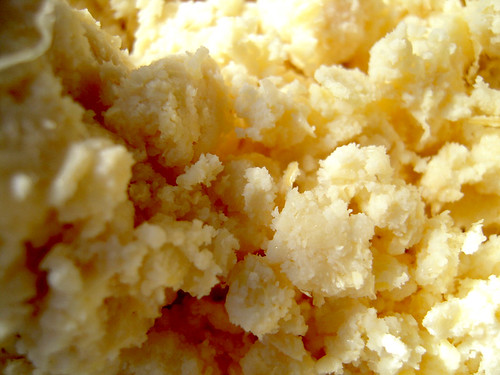
I suspect that because most Americans do not know what to do with it, there is way more
okara in the country than consumable. Therefore, the
okara in the states is literally dirt cheap or free. Large amounts of
okara in the U.S. are used for animal feed and processed foods such as veggie burgers.
Call your local Japanese food grocer or tofu-producer and ask if they can sell or give you some
okara. Chances are, they will be happy to get rid of it.
One of the most famous
okara dishes in Japan is
unohana 卯の花 and is often served as a
otoshi お通し (a free starter that comes automatically with your first drink order in Japanese izakayas). It is eaten at room temperature or chilled so it can be considered a protein-rich salad.
This dish has served me well when:
a) I have no protein dish for tonight's dinner but the butcher shop has already closed.
b) I am invited to a potluck with a bunch of vegetarians and vegans.
c) I am on a tight budget.
Here's how to make it:
A)
1 cup of dashi (or clear veggie broth/water for vegans)
3 tbsp sugar
1 tbsp mirin
1 tbsp sake
2 tbsp shoyu
B)*
2 tbsp vegetable oil
2 carrots, julienned
1 gobo (burdock root) shaved in strips
3 shiitake, sliced
1 lb
okara
* I have also used various veggies that are more unusual or leftover in my fridge such as
kanpyo, spinach and
konnyaku, in addition to carrots and gobo.
1. Combine and whisk together the ingredients in section A. Set aside so that the sugar has time to dissolve.
2. Cut your carrots and shiitake. Shave your gobo pieces as if you are sharpening a pencil with a cutter. Soak the gobo shavings in ice water so they do not brown.

Gobo (burdock root):
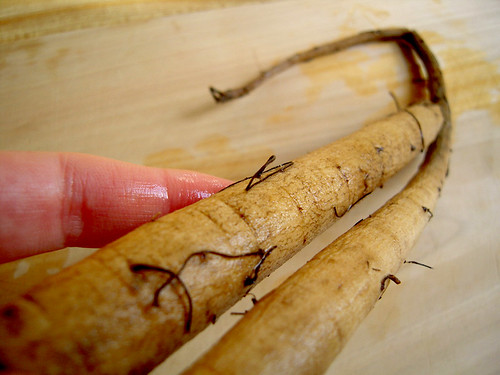
Gobo shavings in ice water:
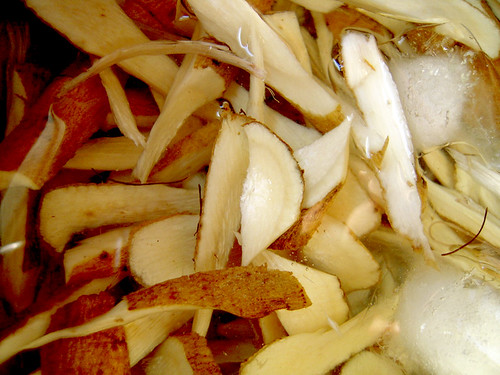
3. Heat the oil in section B over med-high heat in a pan or wok.
4. Saute the carrots and gobo. Once they soften a little bit, add the shiitake and saute for another minute or two.
5. Lower the heat to medium and add the okara to the pan.
6. Drizzle the liquid contents of section A over the okara and vegetable mixture.

7. Thoroughly mix the
okara and vegetables together and keep over medium heat for about 5 minutes while mixing.
8. You can add more shoyu or sugar to taste.
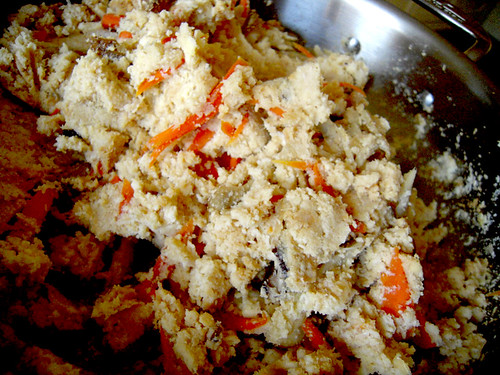
9. Store in air tight containers in the refrigerator. This dish can be eaten cold or at room temperature.
One serving should be about 2-3 tablespoons.
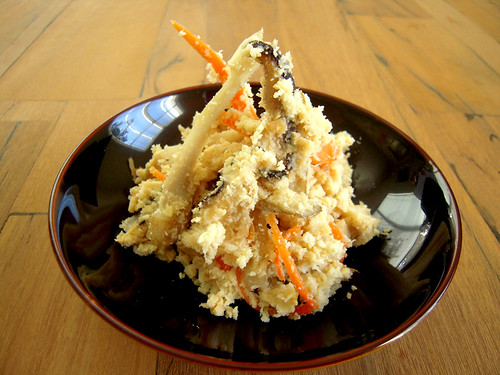
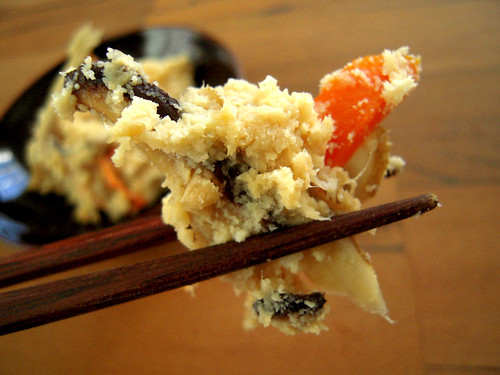
 I discovered okara during my first year in Tokyo, thanks to my neighborhood tofu shop who sold me 400 grams (0.88 lbs) of okara every week for ¥150 (about $1.70). Okara is translated as "tofu lees" or "soy pulp" and is a byproduct of the tofu-making process.
Maybe it's just me, but "soy pulp" sounds kind of gross, so it's one of my missions to spread more awareness to the population at large about this miracle food by referring to it as its Japanese namesake okara. Its literal meaning in Japanese means "shell" referring to the shell casing of the soy bean which is hulled in the tofu-making process.
Websites devoted to the wonders of okara are abundant on the "net" - for example, here, here and here.
The last link takes us to a site giving us a play-by-play of some guy on the okara diet. Perhaps not as gimmicky as the South Beach diet, but the okara diet did cause a bit of a stir nationwide in Japan.
Okara belongs in the upper echelon of healthy and socially responsible foods - healthy because of its high protein, high fiber and low fat content, and socially responsible because it is usually thrown away in the tofu-making process.
But folks, this is the clincher: It's free at my local Japanese grocer, Tokyo Fish Market, in Berkeley, California.
I discovered okara during my first year in Tokyo, thanks to my neighborhood tofu shop who sold me 400 grams (0.88 lbs) of okara every week for ¥150 (about $1.70). Okara is translated as "tofu lees" or "soy pulp" and is a byproduct of the tofu-making process.
Maybe it's just me, but "soy pulp" sounds kind of gross, so it's one of my missions to spread more awareness to the population at large about this miracle food by referring to it as its Japanese namesake okara. Its literal meaning in Japanese means "shell" referring to the shell casing of the soy bean which is hulled in the tofu-making process.
Websites devoted to the wonders of okara are abundant on the "net" - for example, here, here and here.
The last link takes us to a site giving us a play-by-play of some guy on the okara diet. Perhaps not as gimmicky as the South Beach diet, but the okara diet did cause a bit of a stir nationwide in Japan.
Okara belongs in the upper echelon of healthy and socially responsible foods - healthy because of its high protein, high fiber and low fat content, and socially responsible because it is usually thrown away in the tofu-making process.
But folks, this is the clincher: It's free at my local Japanese grocer, Tokyo Fish Market, in Berkeley, California.
 Here's a better look:
Here's a better look:
 I suspect that because most Americans do not know what to do with it, there is way more okara in the country than consumable. Therefore, the okara in the states is literally dirt cheap or free. Large amounts of okara in the U.S. are used for animal feed and processed foods such as veggie burgers.
Call your local Japanese food grocer or tofu-producer and ask if they can sell or give you some okara. Chances are, they will be happy to get rid of it.
One of the most famous okara dishes in Japan is unohana 卯の花 and is often served as a otoshi お通し (a free starter that comes automatically with your first drink order in Japanese izakayas). It is eaten at room temperature or chilled so it can be considered a protein-rich salad.
This dish has served me well when:
a) I have no protein dish for tonight's dinner but the butcher shop has already closed.
b) I am invited to a potluck with a bunch of vegetarians and vegans.
c) I am on a tight budget.
Here's how to make it:
A)
1 cup of dashi (or clear veggie broth/water for vegans)
3 tbsp sugar
1 tbsp mirin
1 tbsp sake
2 tbsp shoyu
B)*
2 tbsp vegetable oil
2 carrots, julienned
1 gobo (burdock root) shaved in strips
3 shiitake, sliced
1 lb okara
* I have also used various veggies that are more unusual or leftover in my fridge such as kanpyo, spinach and konnyaku, in addition to carrots and gobo.
1. Combine and whisk together the ingredients in section A. Set aside so that the sugar has time to dissolve.
2. Cut your carrots and shiitake. Shave your gobo pieces as if you are sharpening a pencil with a cutter. Soak the gobo shavings in ice water so they do not brown.
I suspect that because most Americans do not know what to do with it, there is way more okara in the country than consumable. Therefore, the okara in the states is literally dirt cheap or free. Large amounts of okara in the U.S. are used for animal feed and processed foods such as veggie burgers.
Call your local Japanese food grocer or tofu-producer and ask if they can sell or give you some okara. Chances are, they will be happy to get rid of it.
One of the most famous okara dishes in Japan is unohana 卯の花 and is often served as a otoshi お通し (a free starter that comes automatically with your first drink order in Japanese izakayas). It is eaten at room temperature or chilled so it can be considered a protein-rich salad.
This dish has served me well when:
a) I have no protein dish for tonight's dinner but the butcher shop has already closed.
b) I am invited to a potluck with a bunch of vegetarians and vegans.
c) I am on a tight budget.
Here's how to make it:
A)
1 cup of dashi (or clear veggie broth/water for vegans)
3 tbsp sugar
1 tbsp mirin
1 tbsp sake
2 tbsp shoyu
B)*
2 tbsp vegetable oil
2 carrots, julienned
1 gobo (burdock root) shaved in strips
3 shiitake, sliced
1 lb okara
* I have also used various veggies that are more unusual or leftover in my fridge such as kanpyo, spinach and konnyaku, in addition to carrots and gobo.
1. Combine and whisk together the ingredients in section A. Set aside so that the sugar has time to dissolve.
2. Cut your carrots and shiitake. Shave your gobo pieces as if you are sharpening a pencil with a cutter. Soak the gobo shavings in ice water so they do not brown.
 Gobo (burdock root):
Gobo (burdock root):
 Gobo shavings in ice water:
Gobo shavings in ice water:
 3. Heat the oil in section B over med-high heat in a pan or wok.
4. Saute the carrots and gobo. Once they soften a little bit, add the shiitake and saute for another minute or two.
5. Lower the heat to medium and add the okara to the pan.
6. Drizzle the liquid contents of section A over the okara and vegetable mixture.
3. Heat the oil in section B over med-high heat in a pan or wok.
4. Saute the carrots and gobo. Once they soften a little bit, add the shiitake and saute for another minute or two.
5. Lower the heat to medium and add the okara to the pan.
6. Drizzle the liquid contents of section A over the okara and vegetable mixture.
 7. Thoroughly mix the okara and vegetables together and keep over medium heat for about 5 minutes while mixing.
8. You can add more shoyu or sugar to taste.
7. Thoroughly mix the okara and vegetables together and keep over medium heat for about 5 minutes while mixing.
8. You can add more shoyu or sugar to taste.
 9. Store in air tight containers in the refrigerator. This dish can be eaten cold or at room temperature.
One serving should be about 2-3 tablespoons.
9. Store in air tight containers in the refrigerator. This dish can be eaten cold or at room temperature.
One serving should be about 2-3 tablespoons.



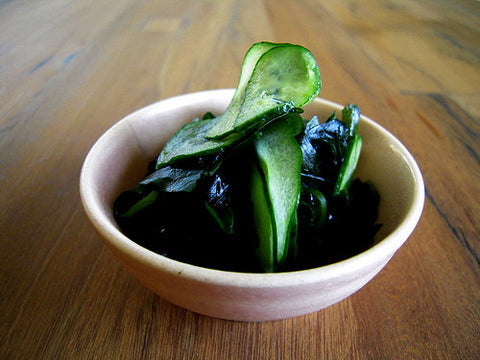


Comments (13)
FYI, key to a smooth okara is to “wash” of put them in water, and strain it through cheese cloth. Then large “shells” are caught in the cloth and final product will be much smoother.
That’s the best looking okara I’ve ever seen!
Amazing!!! Totally recession-friendly AND so good for you! I love this post.
Yamahomo: Wow that’s cool. Yes, I have found that the store bought kinds in Japan (that are packaged) are smoother than this type in America. Must be this straining process. Very interesting. I don’t mind the grain though.
Sakura: Thanks!
Kayoko: Yes, totally recession friendly. And you know I love getting a good deal.
Hey, I also got free okara at Tokyo Fish after your knife sharpening event. I cooked okara with shiitake, carrot, age, konnyaku cabbage and green onion. It was yummy and super heathly.
Nobuko-
Hey, that’s great. Putting cabbage in it sounds like a great idea. Kayoko and I were just talking about how cabbage is really under-rated in the U.S.
Where can I find okara in NY?
Cabbage is underrated… until you have really bad gastro-intestinal issues for the rest of the night.
Dorota, good question, as there weren’t any tofu shops in NYC. I would say, you could go to EN Brasserie in the West Village, or Hibino in Brooklyn Heights, restaurants which both make their own tofu.
You could also ask the random guy who sells tofu from him cart in Chinatown. He was always at the southeast corner of Canal and… Mulberry???
Yamahomo, any insight?
You can buy okara at any Japanese grocery store in the city. They are not as good as homemade kind, of course, but it does the job.